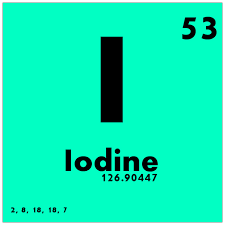What are the characteristics of Iodine?« Back to Questions List
|
Iodine is a chemical element that plays a vital role in the life of humans and vertebrates. Hormone production in thyroid depends on presence of sufficient quantity of iodine. Shortage of the element leads to severe health issues like goiter and intellectual disorder. Iodine is classified as halogen in group 17 on the periodic table. It is a nonmetal discovered in 1811 by Bernard Courtois. It is a lustrous solid element with dark grey colour under normal conditions. Iodine is the most electropositive halogen group member. The electropositive characteristic of iodine causes it to lose electrons during chemical reactions converting the element to positive ion. Among the halogen group members, it is the least reactive. But it forms many chemical compounds. Potassium iodide is one of the most important chemical compounds of iodine. Iodine is the heaviest and least abundant among halogen family. It dissolves only slightly in water. But iodine dissolves very well in some solvents like carbon tetrachloride. It sublimes easily with a purple colour.
Solid iodine creates sores on skin. Iodine vapour leads to irritation of eyes. Iodine which is slightly toxic in minute quantities becomes highly poisonous with more quantities. Iodine is a widely used element. In many of its applications, iodine becomes iodide. Iodine enters atmosphere when surface water vaporizes. Miniscule amount of iodine is produced through human activities like burning coal or fuel. Iodine in air combines with water particles and gets deposited in soil. This interacts with organic matter in the soil. Plants growing in the soil absorb the deposited iodine. When these plants are consumed by cattle and other animals, their body gets the iodine required for their survival. Processing of uranium and plutonium also releases iodine isotopes into air. Iodine is present in nature in many ways. It is found abundantly in ocean and some sea fish. Some water plants store the element in their tissues. Alutarite is a mineral that contains iodine. Chile, Japan, Russia and USA are the leading industrial iodine producing nations. It is extracted from natural brines, oil brines and nitrate deposits in Chile.Why does solid Iodine crystals on heating turn into vapor instead of melting? What are the features of sodium?What is the difference between organic and inorganic substances?
|

